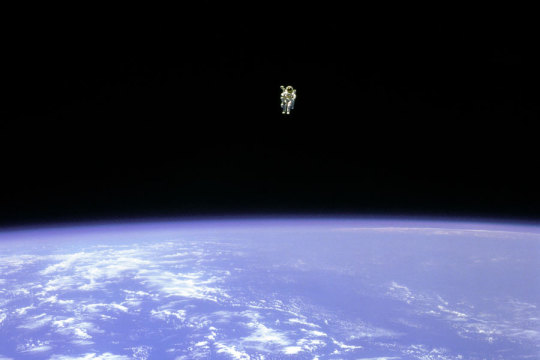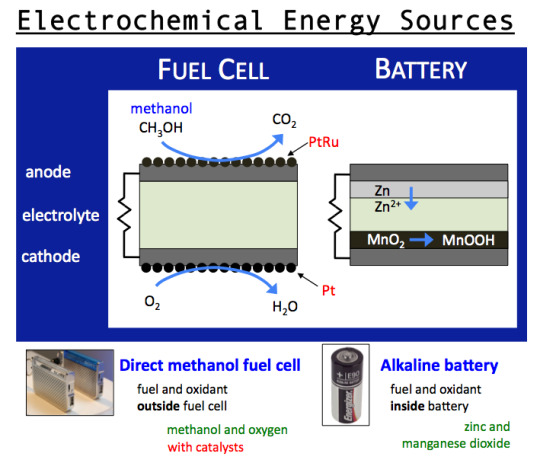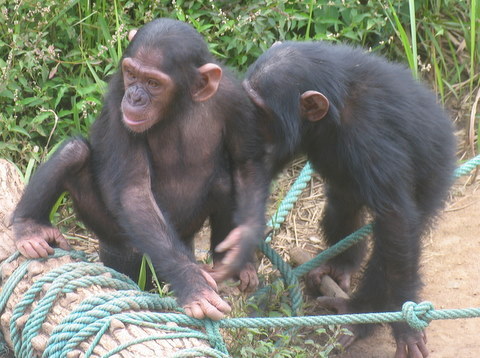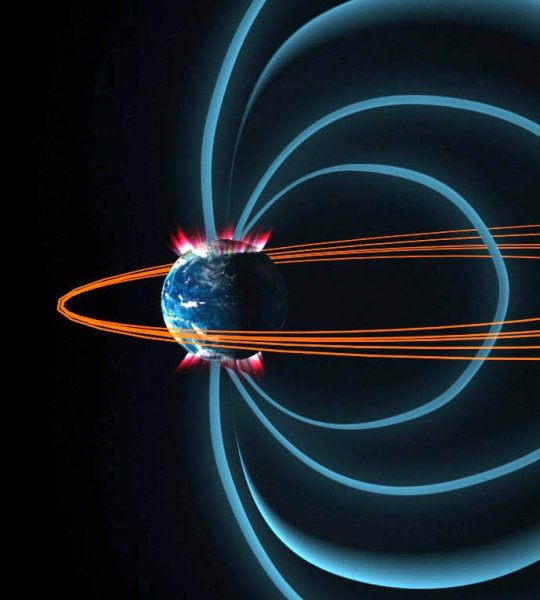Posting articles, news, and anything related to science, technology, futurism, and pretty much any geeky thing I think is cool. Good glayven!
Don't wanna be here? Send us removal request.
Photo
Photo: One lone astronaut floating above the curve of the Earth's atmosphere... #space #photography

“To Fly Free in Space” (via APOD: 2012 January 1)
I think this is my favorite picture ever.
23 notes
·
View notes
Link
Yesterday, after almost no debate, the Indiana State Senate approved a bill that would allow its schools to teach the origin stories of various religions when a class touches on the origin of life. It now moves on to the state's House, where one of its cosponsors is currently the Speaker of the House. Although the bill as written could be used to create a comparative religion class, its sponsor, Senator Dennis Kruse, has made it clear that he hopes to see it foster the teaching of creationism in science classes. The original text of the bill explicitly mentioned creation science; it has since been modified to mention a variety of religions, including Scientology. In a brief interview, Kruse expressed disdain for evolution, calling it a "Johnny-come-lately" theory.
5 notes
·
View notes
Text
How quickly could a mouse become an elephant? Size takes time. #evolution #biology #sizematters
24 million. That’s how many generations a new study estimates it would take to go from mouse- to elephant-sized while operating on land at the maximum velocity of change. “Big animals represent the accumulation of evolutionary change, and change takes time,” said evolutionary biologist Alistair Evans of Australia’s Monash University. “How fast can all of these interconnected changes be made? This to me is the main question that drives why maximum evolutionary rates are fascinating,” said Evans. Source: http://bit.ly/yvRJgt
74 notes
·
View notes
Photo
A 3D holographic display system made from scratch. The LEDs are controlled by a microcontroller, which receives power and commands via the slipring. A magnetic position sensor detects the ring to synchronize the rotational angle with lighting of LEDs.
Source: Research Experience in Education, Real Time Distributed Systems Lab, Texas A&M University
scienceisbeauty

166 notes
·
View notes
Photo

We mentioned storing electricity in a battery. A battery stores energy electrochemically, meaning that electrons are “stored” in a chemical with high energy. Any chemistry that involves electrons as reactants and products is electrochemistry. A fuel cell is similar to a battery: both have two electrodes (anode and cathode) and an electrolyte.
There is more than one way to distinguish a battery and a fuel cell:
Batteries store their chemicals inside the battery, while fuel cells are fed from outside.
Fuel cells often involve catalysis, while batteries may not.
Fuel cells operate continuously. Batteries operate in a batch manner, i.e. charge/discharge.
43 notes
·
View notes
Link
From the unfortunate use of interesting technology department, the United States military has recently developed a self-guided bullet, able to twist, turn, and travel over a mile before it hits its target. Sandia National Laboratories has long been at work with the United States military developing the ultimate “smart bullet.” It announced today that a successful prototype of the bullet was created and tested at distances of over a mile (about 2,000 meters). Sandia’s new technology features a dart-like “smart bullet” that allows for unprecedented movement while in flight. The bullets are able to communicate with sensors that communicate with the bullet, allowing it to steer and maneuver to its destination.
12 notes
·
View notes
Photo

What do you smell like? I mean, really smell like? And WHY do you smell like you smell like?
The natural odors of most animals, besides those like skunk musk, are actually a result of bacteria digesting certain secretions and releasing tell-tale scent compounds. When dogs smell each others’ rear ends, they aren’t really smelling each other (so to speak), they are smelling the characteristic odor products.
But why? The obvious reason is that it provides an odorous fingerprint, a tell-tale tail-tell. Dogs, primates and many other animals smell each other to identify strangers from those they know. Do humans do it? We evolved off of all fours long ago, so having scent glands “down below” wouldn’t do us much good, unless you wanted to bend over in the street to say hello. But we do have quite a garden of smells going on up above, in our armpits and chests.
It turns out that people can be identified by their chest and armpit bacterial odors using an “electronic nose”. It also turns out that we think people with more diverse immune genes smell better than those who are genetically closer to us, a sign that we use our nose to pursue genetic diversity. And most women can tell you some tale of sensitivity to smells when pregnant or ovulating. Some research even indicates that we can smell sick people! Is this why we nuzzle our noses into the napes of necks when getting romantic? To test the smelly waters?
And what about our species’ proclivity toward perfume? Here’s what Rob Dunn theorizes:
Then there is a final piece to this story, the issue of subterfuge. Very early in our human history, we began to take advantage of smells produced elsewhere in nature to perfume our bodies. We think of perfume as lovely in moderation, but there is another way to think of perfume, as a way to cheat. When you apply deodorant or perfume, you are covering up the odors produced by your bacteria with an odor regarded as pleasant, at least to the conscious brain and perhaps, if the perfume and deodorant companies have done their jobs, to the subconscious too, which is important since that seems to be where the decisions are being made11. I’m not sure where this leaves us other than with the impression that nearly the entirety of modern humanity has figured out how to smell like a peacock. Beware both the wolf in sheep’s clothing and the Gonorrhea that smells like Old Spice.
For more, check out: Sick People Smell Bad: Why Dogs Sniff Dogs, Humans Sniff Humans, and Dogs Sometimes Sniff Humans
(via Scientific American)
358 notes
·
View notes
Link
Once AR goggles are AR contact lenses, no one will ever need to leave home... ;) "CRIME scene investigators could one day help solve murders without leaving the office. A pair of augmented reality glasses could allow local police to virtually tag objects in a crime scene, and build a clean record of the scene in 3D video before evidence is removed for processing. The system, being developed by Oytun Akman and colleagues at the Delft University of Technology in the Netherlands, consists of a head-mounted display receiving 3D video from a pair of attached cameras controlled by a laptop carried in a backpack. This arrangement lets the wearer see their surroundings as normal while also allowing them to overlay virtual objects, which are placed using hand gestures."
9 notes
·
View notes
Photo

How Long Does It Take for Earth’s Magnetic Field to Reverse?
As end of the world scenarios begin to ramp up with 2012 now in play, I figured it would be timely to post one of the debunk facts about the switching of our magnetic field reversal which some believe to occur in a matter of days. Most of the folks who believe this we’re likely duped by another 2012 site.
The time it takes for Earth’s magnetic field to reverse polarity is approximately 7000 years, but the time it takes for the reversal to occur is shorter at low latitudes than at high latitudes, a geologist funded by the National Science Foundation (NSF) has concluded. Brad Clement of Florida International University published his findings in this week’s issue of the journal Nature. The results are a major step forward in scientists’ understanding of how Earth’s magnetic field works.
The magnetic field has exhibited a frequent but dramatic variation at irregular times in the geologic past: it has completely changed direction. A compass needle, if one existed then, would have pointed not to the north geographic pole, but instead to the opposite direction. Such polarity reversals provide important clues to the nature of the processes that generate the magnetic field, said Clement.
Since the time of Albert Einstein, researchers have tried to nail down a firm time-frame during which reversals of Earth’s magnetic field occur. Indeed, Einstein once wrote that one of the most important unsolved problems in physics centered around Earth’s magnetic field. Our planet’s magnetic field varies with time, indicating it is not a static or fixed feature. Instead, some active process works to maintain the field. That process is most likely a kind of dynamic action in which the flowing and convecting liquid iron in Earth’s outer core generates the magnetic field, geologists believe.
414 notes
·
View notes
Video
youtube
Scientists thought in the 1970s that this concept for a space station could be ready to become the first orbiting city by the year 2000 -- a mere 35 years in the future. Now that it's 2011 and technology has advanced tremendously, maybe we can make up for lost time and build it in 15 years.
I don't know about you, but I'd be in line to go up for a visit in 2026 as soon as I could.
The design is known as a Stanford torus and was first proposed during the 1975 NASA Summer Study, but reminds me of the design from Doctor Who Ark in Space, which aired in January of that same year... Hmmmm.
7 notes
·
View notes
Text
The downside of mirror neurons. A hidden advantage to those on the autism spectrum, possibly? Interesting, anyway.
ziyadmd:

Two things people say when they hear about research on smoking tobacco are: “Why do research on smoking? We all know it’s bad for you,” and “Smoking is just a bad habit. You can quit if you have enough willpower.”
Now it turns out that a new study published in the The Journal of Neuroscience shows that those people who said, “smoking is a bad habit,” were partially right. In addition to activating brain areas linked to addiction, watching movies in which people smoke activates brain areas that drive the body movements a smoker makes hundreds of times a day while puffing on a cigarette. The physical habit of reaching for a cigarette and moving it up for a drag is learned so well that watching people smoke in the movies makes brain areas responsible for those movements more active, which could contribute to relapse.
Read More
Smoking in Movies: Why Your Brain Thinks It's Cool
4 notes
·
View notes
Video
youtube
Chris Hardwick goes to Gallifrey video from The Late Late Show With Craig Ferguson, Monday February 28, 2011
3 notes
·
View notes
Text
Lunar Lava Tubes Offer Hope for Moon Base
As long as it's not invaded by Cybermen...
NEW DELHI: ISRO scientists have discovered a giant underground chamber on the moon, which could be used as a lunar base by astronauts for inter-planetary missions. Scientists at the Space Applications Centre (SAC), using data gathered from Chandrayaan-I's Terrain Mapping Camera and Hyper Spectral Imager (HySI) payloads, found a 1.2 km long buried, uncollapsed and near horizontal lava tube. The hollow cave situated just above the lunar equator on the nearside of moon, can accommodate a large number of astronauts and scientific instruments, and also protect them from hostile lunar environment. "Such a lava tube could be a potential site for future human habitability on the Moon for future human missions and scientific explorations, providing a safe environment from hazardous radiations, micro-meteoritic impacts, extreme temperatures and dust storms," a team of scientists led by A S Arya of SAC, Ahmedabad said reporting the findings in 'Current Science'.
Source: ISRO finds cave on moon; can be used as an outpost - The Economic Times
5 notes
·
View notes
Video
youtube
Neat video which shows how one driver making a small change to how they drive can have a huge effect on the overall flow of traffic -- breaking up traffic jams & bumper-to-bumper traffic easily. Very cool.
Full description from YouTube:
"On Seattle I-5, this left exit-only lane is usually backed up by a 1/2-mile during rush hour. The left exit ramp leads into the high speed "Express Lanes" under the city. But if it's jammed, you'll lose more time in the jam than you gain from getting on to the express lane. Also, if you miss getting into that lane early, then you're screwed, since nobody in the row of 200 cars will let you in. Merging drivers coming in from righthand ramps are blocked by those already in the jam. And while stuck in that jam, you have to sit in line for many minutes, driving like 2MPH. Just a few drivers occasionally force their way in aggressively, but that nearly halts the exit-lane flow. BUT ...if I let ten cars merge ahead of me as I approach the jam, like magic the whole thing evaporates, and everyone takes off at high speed. Sometimes! (It doesn't work every time.) Unfortunately this video can't show you the view from above. Also, you can't see behind me, so you can't see that my "hole" is the only one in a very long row of cars. Also you can't see the size of the reliable daily jam that was there on every other day, or the jam ahead of me before I arrived and started draining the jam by letting people merge. Note that letting some cars get ahead of you is NOTHING, it doesn't slow you down. On a 30min congested commute at 65MPH, 2sec between cars, if you instead drove 5MPH slower than the rest, how many other cars would pass you? Seventy five! In other words, you're only a "Slowpoke" when a stunningly huge numbers of cars pass you. On the same commute, letting a few (10) cars merge will slow you down INSIGNIFICANTLY: by 20sec out of 30min or less than 1MPH slowing (64.5MPH, not 65MPH.) Ten cars one way or another is too small to matter. Conversely, if you want to drive significantly faster than everyone else, then you need to pass 50-100 other drivers to shorten your commute by a minute or two. If you only managed to pass a few cars, that's called FAILURE, and your speed wasn't increased enough to matter."
1 note
·
View note
Video
youtube
Amazing video shot from a passenger aircraft lucky enough to be flying past as the Discovery launched on the final Space Shuttle mission.
#Science#Space#Space Shuttle final launch#space shuttle launch from the air#space shuttle launch from airplane
0 notes
Text
There is no mysterious planet to see here. Please disperse
I'd missed this story, but according to Bad Astronomy...
NASA supposedly [had] proof of a giant, Jupiter-sized planet orbiting the Sun way beyond Pluto. Let me be clear: while certainly possible, this idea is not at all proven, and in my opinion still pretty unlikely. As usual, this started as a more-or-less accurate media story and is getting inflated as it gets re-reported. As far as I can tell, the original report was in the UK paper The Independent. Here’s the deal. Two astronomers, John Matese and Dan Whitmire, have theorized about the possibility of a previously-undiscovered planet way beyond Pluto for some time. This is not a crazy idea; we see planets orbiting other stars way out, and there’s other evidence big planets can be pretty far out from the Sun (mind you, evidence does not mean proof). As it happens, there are lots of chunks of ice orbiting the Sun pretty far out as well. Some of these have orbits which bring them into the inner solar system, and we seem them as long-period comets. What Matese and Whitmire did was wonder how a big planet would affect the orbits of these comets. If you measured enough of them, would you see the effects of the gravity of this planet? They claim you can, and even gave the planet a tentative name: Tyche. I read their papers, and thought the data were interesting but unconvincing. The sample size was too small. A bigger study was done, but again the effects weren’t quite enough to rise to the level of breakthrough. I’m not saying the astronomers are wrong — the data were certainly provocative, and potentially correct! Just not firm enough.
Source: No, there’s no proof of a giant planet in the outer solar system | Bad Astronomy | Discover Magazine
1 note
·
View note
Video
imaginenoheaven:
Episode six of Carl Sagan’s Cosmos: A Personal Voyage “Travellers’ Tales”
8 notes
·
View notes